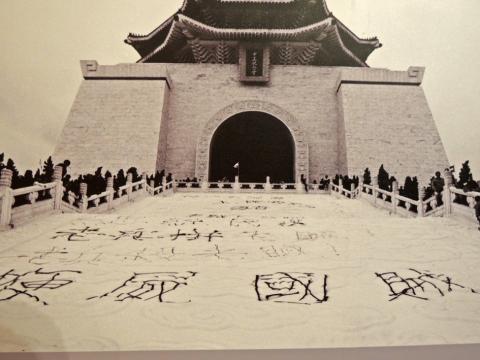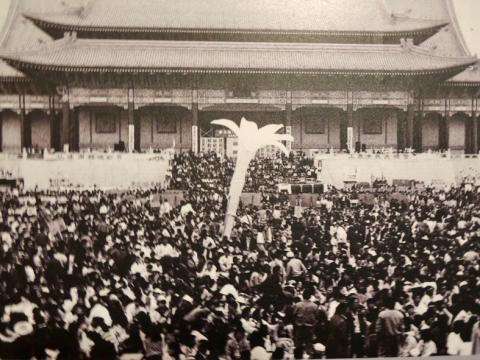Taiwan in Time: March 14 to March 20
On May 11, 1985, student protesters marched through the National Taiwan University (NTU) campus shouting “general elections (普選)” and “I love NTU.”
Mirroring the era’s national political situation, only class representatives could vote for student president. School officials tried to stop the students, who had been calling for direct elections since 1982, but after some fierce arguing, the students went ahead with the plan.

Photo: Tang Chia-lin, Taipei Times
Taiwan was still under martial law and public gatherings were illegal. Students were handed demerits by the school and nothing would change for a few more years.
But this event marked the first open student operation after years of simmering campus unrest. It started with the clandestine circulation of flyers about free speech in 1981 and culminated in the massive Wild Lily Student Movement (野百合學運), where students occupied Chiang Kai-shek Memorial Square (today’s Liberty Square) from March 16 to March 22, 1990.
For decades, campus voices had largely been silent. Student protests over police brutality on April 6, 1949 led to mass arrests and several alleged executions.

Photo: Tang Chia-lin, Taipei Times
When martial law was declared a month later, which lasted 38 years, schools were militarized and all activities placed under strict government control as the country hurtled towards the dark years of the White Terror era.
THE TIMES THEY ARE A CHANGIN’
Teng Pi-yun (鄧丕雲) writes in his book, A History of Taiwan Student Movements in the 80s (80年代台灣學生運動史) that although school activities were still heavily monitored in the late 1970s, the political situation was changing with the rise of the dangwai (黨外, outside the party) movement and its publications critical of the Chinese Nationalist Party’s (KMT) one-party rule, which were often passed around in secret on campus.
During the early 1980s, campus activism was limited to unorganized small groups who called for more freedom of expression through underground posters, graffiti and campus rallies and speeches. Off-campus, some students helped with dangwai campaigns and activities — but faced punishment if their schools found out.
“The biggest difference [before martial law was lifted] was the high level of risk that came with any type of activity,” Teng writes. “Student activists faced a great deal of uncertainty, not knowing what would happen to them.”
But it was no longer the 1950s, and most of the time students just received warnings, demerits and, at worst, expulsion.
Meanwhile, student publication staff were in frequent conflict with school officials, who had to approve all output beforehand. Many publications were suspended, shut down or restructured for bypassing the censor or writing “inappropriate” commentary. This led to the proliferation of underground publications such as National Central University’s Wildfire (野火) and NTU’s Love for Freedom (自由之愛).
Kuo Kai-ti (郭凱迪) writes in a study of Taiwanese student movements that the staff at these publications felt government suppression most directly, and often became the first to take part in student movements.
Teng writes that the first organized movement with a clear objective took place in September 1982, when several NTU clubs banded together before the student government elections and called for change to the system. With their publications censored and activities blocked, the members mostly operated by privately distributing brochures and fliers, including one that appeared on election day that urged the class representatives to boycott the election.
School punishments didn’t deter this emerging revolutionary spirit, as students and school authorities fought back and forth throughout the early 1980s, and by the protests of 1985, it had gone from covert operations to open gatherings. There was no going back.
EXPANDING INTERESTS
Taiwan’s political climate changed dramatically in the second half of the decade, most significantly with the lifting of martial law in 1987. Activists expanded their interests from school affairs to social issues and partook in environmental protection and farmers’ rights movements.
Teng writes that this fervor boiled over to politics relatively late, and started with students challenging campus norms such as inviting members of the opposition movement to speak and holding memorials and forums for the long-suppressed 228 Incident.
Pro-independence student groups would later stage silent protests after independence activist Deng Nan-jung (鄭南榕) self-immolated in 1989, and others provided support for political candidates for elections.
“These activities were like a warm-up for the events to come,” Teng writes.
Tension rose as the March 1990 presidential elections approached. Even though martial law was over, people were still not allowed to vote as the KMT-only candidates were nominated and voted in by members of the National Assembly. These “representatives” were supposed to be popularly elected — but there hadn’t been an election since 1947, earning them the moniker “Ten-thousand year congress (萬年國會).”
Reminiscent of how they stood up against the NTU election system in 1985, students this time took to the national stage, calling for political reform and true democracy as they marched into what is today Liberty Square.
Taiwan in Time, a column about Taiwan’s history that is published every Sunday, spotlights important or interesting events around the nation that have anniversaries this week.

May 11 to May 18 The original Taichung Railway Station was long thought to have been completely razed. Opening on May 15, 1905, the one-story wooden structure soon outgrew its purpose and was replaced in 1917 by a grandiose, Western-style station. During construction on the third-generation station in 2017, workers discovered the service pit for the original station’s locomotive depot. A year later, a small wooden building on site was determined by historians to be the first stationmaster’s office, built around 1908. With these findings, the Taichung Railway Station Cultural Park now boasts that it has

The latest Formosa poll released at the end of last month shows confidence in President William Lai (賴清德) plunged 8.1 percent, while satisfaction with the Lai administration fared worse with a drop of 8.5 percent. Those lacking confidence in Lai jumped by 6 percent and dissatisfaction in his administration spiked up 6.7 percent. Confidence in Lai is still strong at 48.6 percent, compared to 43 percent lacking confidence — but this is his worst result overall since he took office. For the first time, dissatisfaction with his administration surpassed satisfaction, 47.3 to 47.1 percent. Though statistically a tie, for most

As Donald Trump’s executive order in March led to the shuttering of Voice of America (VOA) — the global broadcaster whose roots date back to the fight against Nazi propaganda — he quickly attracted support from figures not used to aligning themselves with any US administration. Trump had ordered the US Agency for Global Media, the federal agency that funds VOA and other groups promoting independent journalism overseas, to be “eliminated to the maximum extent consistent with applicable law.” The decision suddenly halted programming in 49 languages to more than 425 million people. In Moscow, Margarita Simonyan, the hardline editor-in-chief of the

Six weeks before I embarked on a research mission in Kyoto, I was sitting alone at a bar counter in Melbourne. Next to me, a woman was bragging loudly to a friend: She, too, was heading to Kyoto, I quickly discerned. Except her trip was in four months. And she’d just pulled an all-nighter booking restaurant reservations. As I snooped on the conversation, I broke out in a sweat, panicking because I’d yet to secure a single table. Then I remembered: Eating well in Japan is absolutely not something to lose sleep over. It’s true that the best-known institutions book up faster